Related Research Articles
In Mormonism, the restoration refers to a return of the authentic priesthood power, spiritual gifts, ordinances, living prophets and revelation of the primitive Church of Christ after a long period of apostasy. While in some contexts the term may also refer to the early history of Mormonism, in other contexts the term is used in a way to include the time that has elapsed from the church's earliest beginnings until the present day. Especially in the Church of Jesus Christ of Latter-day Saints "the restoration" is often used also as a term to encompass the corpus of religious messages from its general leaders down to the present.
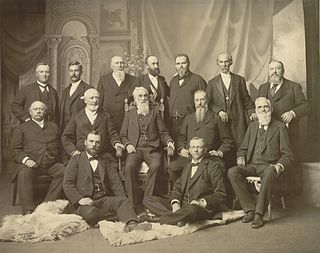
In the Church of Jesus Christ of Latter-day Saints, the Quorum of the Twelve Apostles is one of the governing bodies in the church hierarchy. Members of the Quorum of the Twelve Apostles are apostles, with the calling to be prophets, seers, and revelators, evangelical ambassadors, and special witnesses of Jesus Christ.
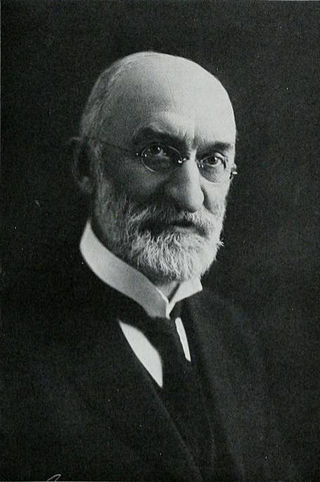
Heber Jeddy Grant was an American religious leader who served as the seventh president of the Church of Jesus Christ of Latter-day Saints. Grant worked as a bookkeeper and a cashier, then was called to be an LDS apostle on October 16, 1882, at age 25. After the death of Joseph F. Smith in late 1918, Grant served as LDS Church president until his death.

Harold Bingham Lee was an American religious leader and educator who served as the 11th president of the Church of Jesus Christ of Latter-day Saints from July 1972 until his death in December 1973.
The status of women in Mormonism has been a source of public debate since before the death of Joseph Smith in 1844. Various denominations within the Latter Day Saint movement have taken different paths on the subject of women and their role in the church and in society. Views range from the full equal status and ordination of women to the priesthood, as practiced by the Community of Christ, to a patriarchal system practiced by the Church of Jesus Christ of Latter-day Saints, to the ultra-patriarchal plural marriage system practiced by the Fundamentalist Church of Jesus Christ of Latter-Day Saints and other Mormon fundamentalist groups.
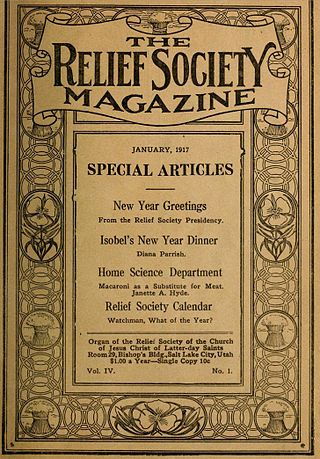
Relief Society Magazine was the official publication of the Relief Society of the Church of Jesus Christ of Latter-day Saints from 1915 to 1970. It succeeded the earlier and privately owned Woman's Exponent, which was begun in 1872. The magazine was an important publishing outlet for Utah women, and was run by women editors. The founding editor, Susa Young Gates, edited the magazine from 1915 to 1922. The December 1970 issue of the Relief Society Magazine was its last. The LDS Church discontinued the magazine as part of the implementation of the Priesthood Correlation Program. Thus, the magazine and several others within the church were replaced by the Ensign.
In the Church of Jesus Christ of Latter-day Saints, the Priesthood Correlation Program began in 1908 as a program to reform the instruction manuals and curriculum of the different organizations of the church. Its scope quickly widened and Correlation came to have large effects on almost every aspect of the church including doctrines, organizations, finances, and ordinances. A significant consequence was to centralize decision making power in the priesthood, particularly the Quorum of the 12 Apostles. More recently, the function of the correlation department has shifted to planning and approving church publications and curriculum and keeping unorthodox information, doctrines and other undesired concepts from being introduced or revived.
This is a timeline of major events in Mormonism in the 20th century.
Ministering is the term for Christian service given to fellow congregants, known as "ward members," within the Church of Jesus Christ of Latter-day Saints. Prior to April 1, 2018, a somewhat similar program within the church was termed "home teaching", "block teaching", and "ward teaching", when performed by male priesthood holders and "visiting teaching," when performed by female members of the church's Relief Society. The previous dual home- and visiting-teaching programs had been designed to allow families to be provided spiritual instruction in their own homes, in addition to weekly church services. The present joint program deemphasizes teaching, replacing it with prayerful consideration given to the needs of one's assigned congregants, finding ways to serve and fellowship them.

Marion Isabelle Sims Spafford, known as Belle S. Spafford, was the ninth Relief Society General President of the Church of Jesus Christ of Latter-day Saints from April 6, 1945, until October 3, 1974. She served longer in this capacity than any other woman in the history of the Relief Society. Spafford also served as president of the National Council of Women from 1968 to 1972, traveling and speaking both nationally and internationally in that position.
The Young Women is a youth organization of the Church of Jesus Christ of Latter-day Saints. The purpose of the Young Women organization is to help each young woman "be worthy to make and keep sacred covenants and receive the ordinances of the temple."
Sunday School is an organization of the Church of Jesus Christ of Latter-day Saints. All members of the church and any interested nonmembers, age 11 and older, are encouraged to participate in Sunday School.
In the Latter Day Saint movement, the Quorum of the Twelve is one of the governing bodies of the church hierarchy organized by the movement's founder Joseph Smith and patterned after the Apostles of Jesus. Members are called Apostles, with a special calling to be evangelistic ambassadors to the world.
Ardeth Greene Kapp was the ninth Young Women general president of the Church of Jesus Christ of Latter-day Saints from 1984 to 1992.
Harry Donl Peterson was a religion professor at Brigham Young University (BYU) who primarily studied topics related to the Book of Mormon and Pearl of Great Price.

Since Mormonism’s foundation, Black people have been members, however the church placed restrictions on proselytization efforts among black people. Before 1978, black membership was small. It has since grown, and in 1997, there were approximately 500,000 black members of the church, mostly in Africa, Brazil and the Caribbean. Black membership has continued to grow substantially, especially in West Africa, where two temples have been built. By 2018, an estimated 6% of members were black worldwide. In the United States, approximately 1% of members are black.
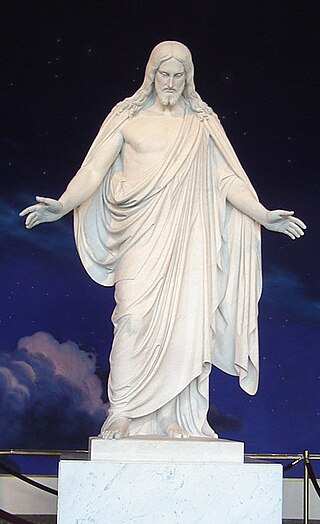
The following outline is provided as an overview of and a topical guide to the Church of Jesus Christ of Latter-day Saints.
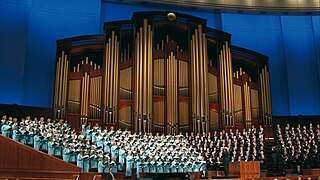
General Conference is a gathering of members of the Church of Jesus Christ of Latter-day Saints, held biannually every April and October at the Conference Center in Salt Lake City, Utah. During each conference, church members gather in a series of two-hour sessions to listen to the faith's leaders. It consists of five general sessions. From April 2018 to April 2021, the priesthood session was held during the April conference, with a General Women's Session held during October's conference. The Saturday evening session was changed to a general session in October 2021. The conference also generally includes training sessions for general and area leaders. Although each general conference originates from Salt Lake City, the conference is considered an international event for the church. The sessions are broadcast worldwide in over 90 languages, primarily through local and international media outlets, and over the Internet.
References
- 1 2 3 4 5 "June Conference 1975—The End of an Era", New Era , October 1975
- 1 2 "'Serving the One': Glimpses of June Conference". New Era . September 1974.
- 1 2 "June Conference". New Era . November 1973.
- 1 2 3 4 5 6 7 8 9 10 Peterson, Janet; Gaunt, LaRene (1993). Keepers of the Flame: Presidents of the Young Women. Salt Lake City: Deseret Book. ISBN 0875796702.
- 1 2 3 Embry 2008 , p. 29
- 1 2 Embry, Jessie L. (2010). "Expansion: 1941-Present". In W. Paul Reeve; Ardis E. Parshall (eds.). Mormonism: A Historical Encyclopedia . Santa Barbara, CA: ABC-CLIO. p. 64. ISBN 9781598841084.
- 1 2 3 4 Cannon, Elaine Anderson (1992). "Young Women". In Daniel H. Ludlow (ed.). Encyclopedia of Mormonism . Vol. 4. New York: Macmillan. pp. 1617–19. ISBN 0028796039.
- ↑ "Young Women Timeline". Mormon Women's Studies Resource. Harold B. Lee Library, Brigham Young University. November 13, 2014. Retrieved 2015-02-01.
- 1 2 Esplin, Scott C. (2011). "Tying It to the Priesthood: Harold B. Lee's Restructuring of the Young Men Organization". In David J. Whittaker; Arnold K. Garr (eds.). A Firm Foundation: Church Organization and Administration. Provo, UT: Religious Studies Center, Brigham Young University. ISBN 9780842527859.
- ↑ Jensen, Clayne R. (1992). "Sports". In Daniel H. Ludlow (ed.). Encyclopedia of Mormonism . Vol. 3. New York: Macmillan. p. 1410. ISBN 0028796020.
- ↑ Embry 2008 , p. 143
- 1 2 3 4 Peterson, Janet (2011). "Young Women of Zion: An Organizational History". In David J. Whittaker; Arnold K. Garr (eds.). A Firm Foundation: Church Organization and Administration. Provo and Salt Lake City, UT: Religious Studies Center, Brigham Young University, and Deseret Book. pp. 277–94. ISBN 9780842527859.
- ↑ Embry 2008 , pp. 151–52
- ↑ "MIA June Conference Plea: 'Master Art Of Reaching Hearts'". Church News . June 28, 1969. p. 3.
- ↑ Embry 2008 , pp. 164–65
- 1 2 Allen, James B.; Leonard, Glen M. (1976). The Story of the Latter-day Saints . Deseret Book. p. 628. ISBN 0-87747-594-6.
- ↑ Bytheway, John (2003). A History of "Especially For Youth" — 1976-1986 (Master of Arts thesis). Digital Collections, Harold B. Lee Library, Brigham Young University. p. 10. Archived from the original on 11 June 2011. Retrieved 26 March 2015.